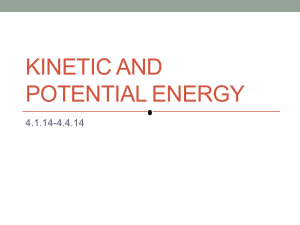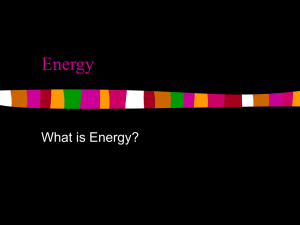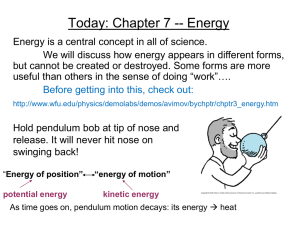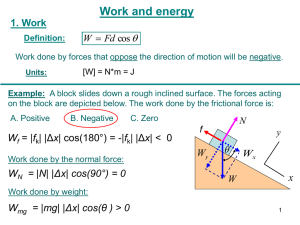(A) work. - Bishop Moore High School
advertisement
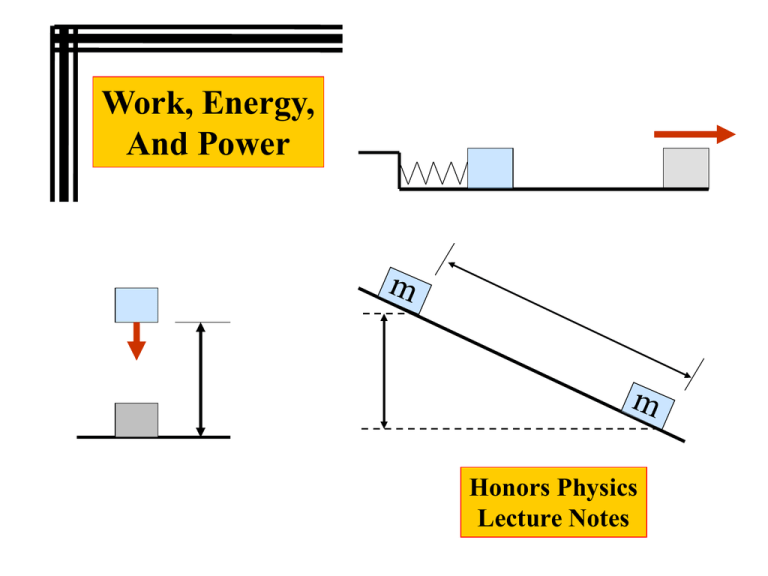
Work, Energy, And Power Honors Physics Lecture Notes Energy Topics 5-01 5-02 5-03 5-04 5-05 5-06 Work Kinetic Energy & the Work Energy Theorem Gravitational Potential Energy Spring Potential Energy Systems and Energy Conservation Power Energy Work The work done by a constant force is defined as the distance moved multiplied by the component of the force in the direction of displacement: W Fd cos θ Energy Work What is the correct unit of work expressed in SI units? (A) kg m2/s2 (B) kg m2/s (C) kg m/s2 (D) kg2 m/s2 Work How much work did the movers do (horizontally) pushing a 160 kg crate 10.3 m across a rough floor without acceleration, if the effective coefficient of friction was 0.50? Work Can work be done on a system if there is no motion? (A) Yes, if an outside force is provided. (B) Yes, since motion is only relative. (C) No, since a system which is not moving has no energy. (D) No, because of the way work is defined. Work Object falls in a gravitational field m Wg Fg d cos θ mg h Wg mgh cos 0 m Wg = mgh Energy Work A 50 N object was lifted 2.0 m vertically and is being held there. How much work is being done in holding the box in this position? (A) more than 100 J (B) 100 J (C) less than 100 J, but more than 0 J (D) 0 J Work Work done by forces that oppose the direction of motion, such as friction, will be negative. v f Centripetal forces do no work, they are always perpendicular to the direction of motion. d v Fc Energy Work Does a centripetal force acting on an object do work on the object? (A) Yes, since a force acts and the object moves, and work is force times distance. (B) No, because the force and the displacement of the object are perpendicular. (C) Yes, since it takes energy to turn an object. (D) No, because the object has constant speed. Work Friction acts on moving object m m d f Wf fd cos θ f mN Wf μmgd cos 180o f mmg Wf μmgd Energy Work The area under the curve, on a Force versus position (F vs. x) graph, represents (A) work. (B) kinetic energy. (C) power. (D) potential energy. Work On a plot of Force versus position (F vs. x), what represents the work done by the force F? (A) the slope of the curve (B) the length of the curve (C) the area under the curve (D) the product of the maximum force times the maximum x Kinetic Energy and the Work Energy Theorem Force acts on a moving object vf vi Kinetic Energy F m x 2 vf 2 vi F ma 2ax a 2 vf 2 vi F 2 x m 2 mv 2 m vf v i Fx 2 2 2 F m Fx Work mv f2 2 mv i2 2 Work Δ Kinetic Energy Energy Kinetic Energy and the Work Energy Theorem (Problem) A baseball (m = 140 g) traveling 32 m/s moves a fielder’s glove backward 25 cm when the ball is caught. What was the average force exerted by the ball on the glove? Kinetic Energy and the Work Energy Theorem The quantity 2 1 mv 2 is (A) the kinetic energy of the object. (B) the potential energy of the object. (C) the work done on the object by the force. (D) the power supplied to the object by the force. Kinetic Energy and the Work Energy Theorem (Problem) (a) If the KE of an arrow is doubled, by what factor has its speed increased? Kinetic Energy and the Work Energy Theorem (Problem) (b) If the speed of an arrow is doubled, by what factor does its KE increase? Kinetic Energy and the Work Energy Theorem Work done is equal to the change in the kinetic energy: Wnet KEf KE i • If the net work is positive, the kinetic energy increases. • If the net work is negative, the kinetic energy decreases. Energy Gravitational Potential Energy When an object is thrown upward. Positive work done by the gravitational force Negative work done by the gravitational force Earth Energy Gravitational Potential Energy An object can have potential energy by virtue of its position. Familiar examples of potential energy: • A wound-up spring • A stretched elastic band • An object at some height above the ground Energy Gravitational Potential Energy In raising a mass m to a height h, the work done by the external force is y2 Fex mt Wext Fextd cos where 0 mg y 2 y 1 Wext mgh h mg y1 We therefore define the gravitational potential energy: PE g mgh Energy Gravitational Potential Energy The quantity mgh is (A) the kinetic energy of the object. (B) the gravitational potential energy of the object. (C) the work done on the object by the height. (D) the power supplied to the object by the force. Gravitational Potential Energy (Problem) How high will a 1.85 kg rock go if thrown straight up by someone who does 80.0 J of work on it? Neglect air resistance. Spring Potential Energy x F = kx F Favg Work kx kx2 2 0 x Energy Spring Potential Energy The restoring force of a spring is Fs kx where k is called the spring constant, and needs to be measured for each spring. The force required to compress or stretch a spring is: Fp kx Energy Spring Potential Energy The force increases as the spring is stretched or compressed further. We find that the potential energy of the compressed or stretched spring, measured from its equilibrium position, can be written: PE S kx2 2 F Favg Work kx kx2 2 0 x Energy Spring Potential Energy The quantity 2 1 kx 2 is (A) the kinetic energy of the object. (B) the elastic potential energy of the object. (C) the work done on the object by the displacement. (D) the power supplied to the object by the force. Spring Potential Energy (Problem) A spring (with k = 53 N/m) hangs vertically next to a ruler. The end of the spring is next to the 15 cm mark on the ruler. If a 2.5 kg mass is now attached to the end of the spring, where will the end of the spring line up with the ruler marks? F kx mg kx x mg k 2.5 kg 9.8 m/s 2 0.46 m 53 N/m 46 cm 15 cm 61 cm - mark Energy Systems and Energy Conservation The sum of the changes in the kinetic energy and in the potential energy is zero – the kinetic and potential energy changes are equal but opposite in sign. This allows us to define the total mechanical energy: Total Mechanical Energy KE PE And its conservation: ΔKE ΔPE 0 Energy Systems and Energy Conservation If there is no friction, the speed of a roller coaster will depend only on its height compared to its starting height. y Energy Systems and Energy Conservation Ball dropped from rest falls freely from a height h. Find its final speed. mv 2 mgh 2 Wg KE h mgh mv 2 2 v 2gh v Energy Systems and Energy Conservation A block of mass m compresses a spring (force constant k) a distance x. When the block is released, find its final speed. v m m x kx 2 mv 2 2 2 Ws KE v kx 2 2 mv 2 kx 2 m 2 Energy Systems and Energy Conservation When released from rest, the block slides to a stop. Find the distance the block slides. vf = 0 Friction (m) m m k x Ws kx2 d mmgd 2 Ws Wf kx d kx 2 2mmg 2 mmgd 2 Energy Systems and Energy Conservation A block released from rest slides freely for a distance d. vi = 0 mgh 2 d Wg KE h mgh Find the final speed of the block mv 2 sin d h = d sin() 2 2 V=? h mv mgd sin v mv 2 2 2gd sin Energy Power Power is the rate at which work is done – Average Power Work Energy Transformed Time Time In the SI system, the units of power are Watts: 1Watt 1 Joule Second The difference between walking and running up these stairs is power – the change in gravitational potential energy is the same. Energy Power Power is also needed for acceleration and for moving against the force of gravity. The average power can be written in terms of the force and the average velocity: v F Fr d P W t Fd Fv t Energy Power (Problem) A 1000 kg sports car accelerates from rest to 20 m/s in 5.0 s. What is the average power delivered by the engine? Fnet = ma a = (20m/s – 0)/5.0s = 4.0 m/s2 Fnet = (1000 kg)(4.0 m/s2) = 4000 N P = Fvave P = (4000N)[(0 + 20 m/s)/2] P = (4000N)(10 m/s) Power = 40,000 W Energy



